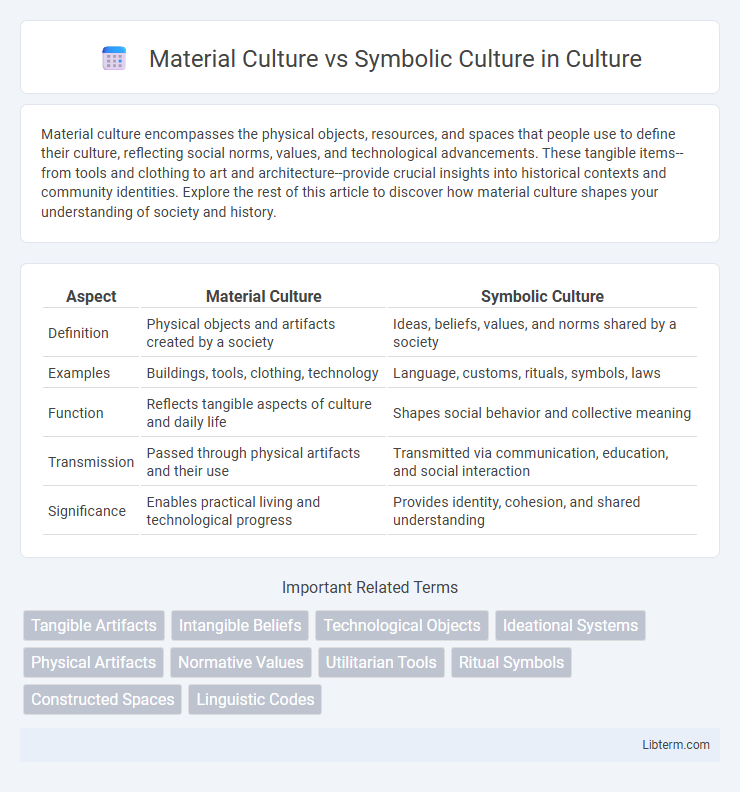Material culture encompasses the physical objects, resources, and spaces that people use to define their culture, reflecting social norms, values, and technological advancements. These tangible items--from tools and clothing to art and architecture--provide crucial insights into historical contexts and community identities. Explore the rest of this article to discover how material culture shapes your understanding of society and history.
Table of Comparison
| Aspect | Material Culture | Symbolic Culture |
|---|---|---|
| Definition | Physical objects and artifacts created by a society | Ideas, beliefs, values, and norms shared by a society |
| Examples | Buildings, tools, clothing, technology | Language, customs, rituals, symbols, laws |
| Function | Reflects tangible aspects of culture and daily life | Shapes social behavior and collective meaning |
| Transmission | Passed through physical artifacts and their use | Transmitted via communication, education, and social interaction |
| Significance | Enables practical living and technological progress | Provides identity, cohesion, and shared understanding |
Introduction to Material and Symbolic Culture
Material culture consists of tangible physical objects created and used by a society, such as tools, clothing, and architecture, reflecting the technological and economic aspects of a culture. Symbolic culture encompasses intangible elements like language, beliefs, values, and rituals, which convey meaning and guide social behavior within a community. Understanding the distinction between material and symbolic culture is essential for analyzing how societies express identity and maintain social cohesion.
Defining Material Culture
Material culture encompasses the physical objects, artifacts, and technology created and used by a society, reflecting its technological capabilities and daily life practices. These tangible items serve as concrete evidence of human activity and societal development, including tools, clothing, architecture, and art. Material culture contrasts with symbolic culture, which consists of non-material elements like beliefs, values, and language that influence social behavior and identity.
Understanding Symbolic Culture
Symbolic culture encompasses the ideas, beliefs, values, norms, and language that shape a society's worldview and social interactions, serving as the foundation for shared meaning and communication within a group. Unlike material culture, which includes tangible objects and artifacts, symbolic culture is intangible and influences behavior and social cohesion through symbols and rituals. Understanding symbolic culture is essential for interpreting how societies create identity, maintain social order, and transmit cultural knowledge across generations.
Key Differences Between Material and Symbolic Culture
Material culture consists of physical objects, artifacts, and technology created and used by a society, while symbolic culture encompasses non-material elements such as beliefs, values, language, and norms. Material culture can be directly observed and touched, whereas symbolic culture exists in abstract forms and shapes social interactions and collective identity. The key difference lies in tangibility; material culture is concrete and linked to everyday practical life, while symbolic culture provides meaning and guides behavior through shared symbols and meanings.
Examples of Material Culture in Society
Material culture includes tangible objects such as tools, clothing, architecture, and technology that humans create and use in daily life, reflecting economic activities and technological development. Examples in society include smartphones, vehicles, artworks, and traditional crafts, each embodying cultural values and historical context. These physical artifacts serve as concrete evidence of cultural identity and social evolution.
Examples of Symbolic Culture in Society
Symbolic culture encompasses non-material elements such as language, beliefs, norms, rituals, and values that shape social interactions and collective identity. Examples include national flags that evoke patriotism, religious symbols like the cross or crescent representing faith communities, and language as a system of shared meaning facilitating communication. These symbolic artifacts and practices influence behavior and social cohesion beyond the tangible objects found in material culture.
The Interplay Between Material and Symbolic Culture
Material culture, encompassing physical objects like tools, clothing, and technology, directly shapes everyday human experiences and societal functions. Symbolic culture, consisting of beliefs, values, language, and norms, provides the meaning and interpretation that frame those material objects within a cultural context. The interplay between material and symbolic culture occurs as societies imbue objects with symbolic significance, influencing identity, social organization, and cultural continuity.
The Role of Culture in Shaping Identity
Material culture, comprising physical objects and artifacts, shapes identity by reflecting tangible aspects of daily life, technology, and social status, influencing how individuals and groups perceive themselves and others. Symbolic culture, including language, values, beliefs, and rituals, plays a crucial role in constructing shared meanings and collective identity, guiding behaviors and social norms. Together, material and symbolic culture interact dynamically to form a cohesive sense of identity within societies.
Impact of Globalization on Material and Symbolic Culture
Globalization accelerates the exchange of material culture by spreading goods, technology, and architectural styles across borders, leading to increased cultural convergence and hybridization. Symbolic culture, including language, rituals, and values, evolves as global communication fosters the blending and reinterpretation of beliefs and customs, sometimes causing cultural homogenization or resistance to cultural loss. The impact of globalization on both material and symbolic culture reshapes identities and social norms, highlighting the dynamic interplay between preserving heritage and embracing global influences.
Conclusion: Bridging Material and Symbolic Dimensions
Material culture and symbolic culture are deeply interconnected frameworks shaping human experience, where physical artifacts embody intangible values and beliefs. Understanding the dynamic relationship between objects and their meanings enables a holistic perspective on cultural identity and social behavior. Bridging these dimensions fosters comprehensive insights into how societies express and preserve their heritage through both tangible and symbolic mediums.
Material Culture Infographic

 libterm.com
libterm.com